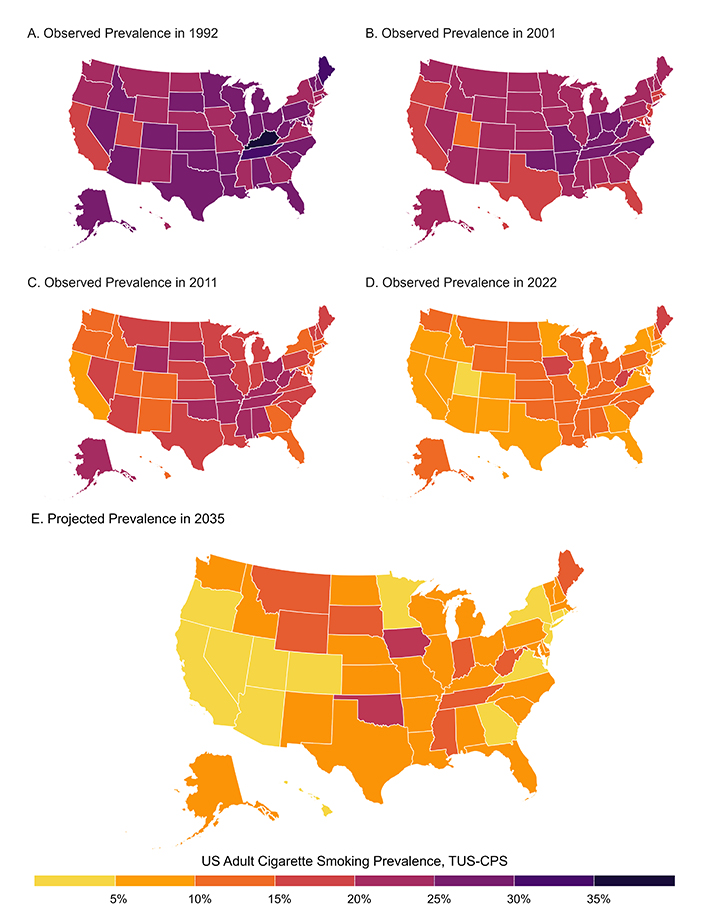Young Adults Drive Historic Decline in Smoking
Despite gains, slower decline among adults over 50 may delay reductions in smoking-related deaths
Story by:
Published Date
Article Content
Researchers at University of California San Diego found that cigarette smoking continues to decline across the United States, largely driven by young adults. Their study, published in JAMA Network Open on April 25, 2025, reveals that the states with historically high smoking rates have seen the most dramatic declines. However, smoking cessation progress among adults over 50 has been much slower, which could prolong the public health burden of smoking-related diseases and death.
“The rapid decline in smoking among young adults is clear evidence that the smoking epidemic will come to an end in our lifetime,” said Matthew Stone, Ph.D., first author and assistant professor at the UC San Diego Herbert Wertheim School of Public Health and Human Longevity Science and Moores Cancer Center member. “Indeed, we project that the national smoking prevalence will be under 5% by 2035. However, the much slower decline in smokers over the age of 50, particularly in previously high smoking states, will mean that the high rates of lung cancer, heart disease and chronic obstructive pulmonary disease that are caused by lifelong smoking will take longer to decrease.”
Researchers used the publicly available Tobacco Use Supplements to the U.S. Census Bureau’s Current Population Survey. The survey is a large — approximately 54,000 households — monthly representative survey that provides information on employment and economic well-being. For this study, all analyses were conducted between June and October 2024. A total of 1.77 million respondents were analyzed.
The study found:
- Large differences in smoking prevalence existed across U.S. states in both the 1990s and in 2022, when the study authors obtained smoking prevalence estimates. The most significant decline in smoking happened in states with historically high smoking rates.
- Differences in prevalence across age, sex, race and ethnicity, and education persisted across the years. There was a larger decline in young adult smoking compared with other states with lower historical rates of smoking. However, the gain was offset by a much slower decline among adults 50 and older.
Since the 1950s, when researchers first linked smoking to lung cancer, national smoking rates have dropped dramatically. In 1955, 56.9% of U.S. adults smoked. By the turn of the century, that figure had fallen by more than half, and by 2022, it had dropped again by 50%. The trend is expected to continue, with smoking rates projected to halve again by 2035. Recent evidence indicates that states that have made the greatest progress in reducing smoking have also seen the largest declines in lung cancer mortality — typically with a 16-year lag.
“While the ongoing decline in cigarette smoking is a major public health success story,” said John P. Pierce, Ph.D., corresponding author and Distinguished Professor at the Herbert Wertheim School of Public Health and Human Longevity Science and Moores Cancer Center. “Recent evidence suggests that the tobacco industry has successfully recruited a new generation of teenagers into e-cigarette use and nicotine addiction. Further research is needed to assess the long-term impact of this shift.”
Read the full study.

Since the 1950s, when researchers first linked smoking to lung cancer, national smoking rates have dropped dramatically. Photo credit: Matthew Stone/John Pierce, UC San Diego Herbert Wertheim School of Public Health and Human Longevity Science
Additional co-authors on the study include: Brian Dang, M.S., Sara B. McMenamin, Ph.D., David R. Strong, Ph.D., Yuyan Shi, Ph.D., Karen Messer, Ph.D., and Dennis R. Trinidad, Ph.D., at UC San Diego; Candice D. Donaldson, Ph.D., and Xueying Zhang, M.D., from the Tobacco Control Branch, California Department of Public Health (CDPH).
The study was funded, in part, by the Tobacco-Related Disease Research Program (TRDRP) of the University of California Office of the President (Nos. T31Ir-1584 and T32IR-4988) and CDPH (No. 22-10341.)
Matthew Stone reported contract work from CDPH during the conduct of the study. Yuyan Shi reported grants from CDPH during the conduct of the study. No other disclosures.
You May Also Like
Stay in the Know
Keep up with all the latest from UC San Diego. Subscribe to the newsletter today.




